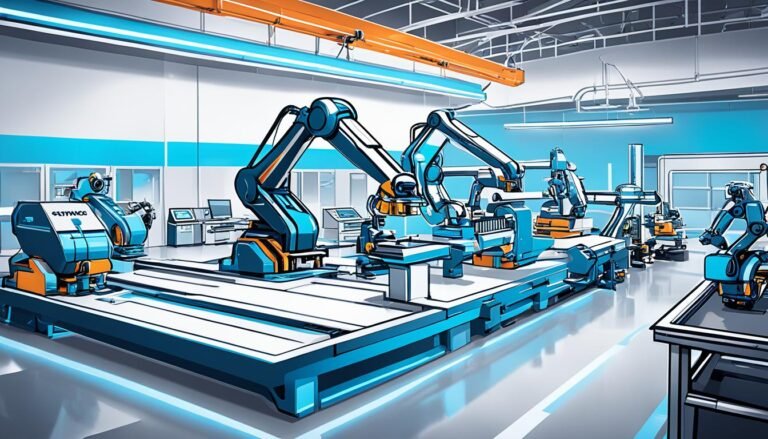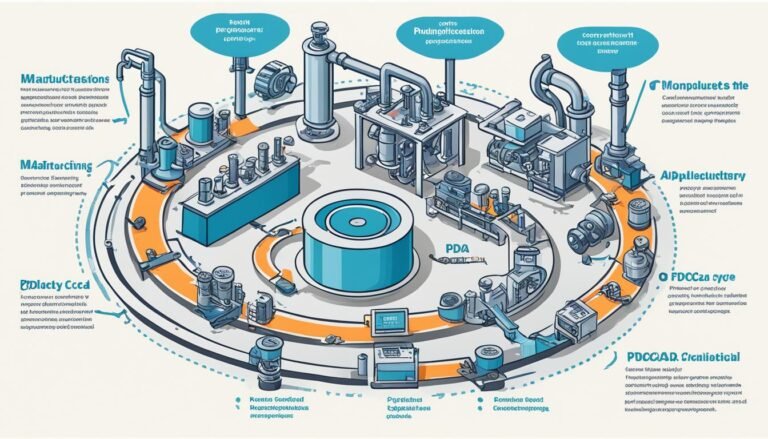Quality Control and Assurance in Manufacturing
Did you know that quality problems in manufacturing can cause losses of 15% to 40% of revenue? This fact shows how important it is to have good quality management systems. In today’s competitive world, having a strong Quality Control and Assurance system is key. It ensures products are top-notch, customers are happy, and things keep getting better.
Companies like MachineMetrics show how new software can make manufacturing Quality Control and Assurance better. They connect machines to data platforms and analyze downtime. This helps them make smart decisions and follow strict quality standards like FDA 21 CFR 820 and ISO 9001. These steps keep products consistent, avoid expensive recalls, and protect their good name in the industry.
Key Takeaways
- Quality issues can lead to revenue losses between 15% and 40%.
- Robust Quality Control and Assurance systems are vital for product excellence and customer satisfaction.
- Companies like MachineMetrics use data platforms to enhance quality oversight.
- Compliance with standards like FDA 21 CFR 820 and ISO 9001 is crucial.
- Effective quality systems prevent recalls and maintain industry reputation.
Introduction to Quality Control and Assurance
Quality control and assurance are key to keeping products top-notch in many industries. They use Quality Management Systems and methods like defect detection. This helps make sure manufacturing processes work well and customers are happy.
These systems cover many parts of making things better, like getting high-quality materials, moving goods fast, keeping work areas tidy, and having skilled workers. Each part is important for making and keeping products great.
In Quality Management Systems, it’s important to know the difference between quality control and quality assurance. Quality control checks products to meet certain standards. Quality assurance makes sure all steps are followed to show and keep up with quality standards.
“For instance, in aircraft manufacturing, quality control and assurance involve documenting, tracking, and inspecting every item and phase to meet stringent standards.”
Quality control methods include the x-bar chart, Six Sigma, 100% inspection, and the Taguchi Method. These methods are key to stopping defects and making processes better.
- Professional, scientific and technical services: $48,680
- Manufacturing: $46,390
- Wholesale trade: $43,880
- Administrative and support services: $35,940
Putting these methods into a strong Quality Management System helps keep high standards. It also cuts down on defective products. Testing at every step is key. It finds problems early and stops them before they get worse, protecting customers and the company’s reputation.
Key Components of a Quality Management System
Having a Quality Management System (QMS) is key for any manufacturing company. It helps meet Industry Regulations and improve Process Optimization. This system has a clear structure that makes sure operations follow quality standards. This leads to reliable products and happy customers.
Quality Assurance vs. Quality Control
Quality Assurance (QA) and Quality Control (QC) are vital parts of a Quality System. QA makes sure Quality Requirements are met by taking steps to prevent defects. QC uses methods and checks to make sure products are up to standard.
QC keeps an eye on products and checks them against standards. This makes sure they meet the Quality Requirements, making the Quality System work well.
ISO Standards
ISO 9001:2015 is a top standard for Quality Management Systems in manufacturing. It helps companies make sure their quality plans match up with both their own and outside rules. The FDA is making their rules match ISO 13485, which makes global standards better. Medical devices are sorted by risk level and must follow EU MDR 2017/745 rules.
Implementing QMS
Putting a QMS in place means following steps to make quality a big part of a company’s work. This includes:
- Defining key business processes and setting clear Quality Requirements.
- Training staff to know how to follow and keep up the Quality System.
- Improving workflows to cut down on waste and make things run smoother.
- Creating a strong supply chain management system to check supplier quality.
By doing these things, the QMS not only meets rules but also keeps getting better. This leads to quality that goes beyond what customers expect.
Techniques and Tools for Quality Control
High-quality manufacturing needs the right techniques and tools. Important methods like Statistical Process Control, Six Sigma, Product Inspection, and Lean Manufacturing are key. They help improve Production Efficiency, reduce Defect Rates, and boost Operational Excellence.
Statistical Process Control
Statistical Process Control (SPC) started in the 1920s. It uses statistics to monitor and manage processes. Walter A. Shewhart created SPC to catch and prevent problems early, keeping production smooth.
This method combines data analysis with process management. It helps make production more efficient and cuts down on variation.
Six Sigma Methodologies
Six Sigma aims for almost perfect manufacturing, aiming for just 3.4 defects per million chances. Motorola first developed it, and it has saved companies like Motorola about $16 billion by setting high standards. Tools like DMAIC and DMADV are key to reducing defects and improving operations.
Product Inspection
Product inspection checks that each product meets quality standards before it goes to customers. In sectors like pharmaceuticals and food, 100% inspection is common. This method finds and fixes defects, keeping efficiency high and reducing defects.
Lean Manufacturing
Lean Manufacturing focuses on cutting waste in production, making processes smoother and using resources better. It targets “Seven Deadly Wastes” like overproduction and inefficiencies. Lean practices like the 5S system and 5 Whys method improve operations.
Continuous Improvement with Kaizen encourages small, daily innovations. This supports Lean goals.
| Tool/Technique | Key Focus | Benefits |
|---|---|---|
| Statistical Process Control (SPC) | Early detection and prevention of issues | Improved Production Efficiency |
| Six Sigma | Achieving less than 3.4 defects per one million units | Significant Defect Rate Reduction |
| Product Inspection | Ensuring product meets quality standards | Reduced Defect Rate |
| Lean Manufacturing | Eliminating waste in production | Operational Excellence |
Importance of Quality Control and Assurance in Manufacturing
Quality control and assurance are key to making manufacturing better and building Customer Confidence, Stakeholder Trust, and Regulatory Compliance. By using strong quality control steps, like checking materials and finished products, manufacturers have gotten better at making things.
Companies that focus on quality control and assurance can cut their costs by up to 40%. Keeping track of quality at every step helps save resources and fix problems early. This avoids the need for costly fixes later.
Investing in quality assurance brings big returns, from $6 to $16 for every $1 spent. This comes from preventing defects, making customers happy, and cutting costs. Also, 94% of top manufacturing leaders see quality control as vital for their success. It helps them do better and gain Stakeholder Trust.
Using quality management systems (QMS) with tools like Six Sigma leads to ongoing improvement. This ensures following rules and makes production more efficient. This method is key in fields like pharmaceuticals and aerospace, helping them avoid legal issues and fines.
The Rodon Group is a great example. They focus on quality by having a QC lab with top-notch equipment and sticking to ISO 9001:2015 standards. This approach saves money by catching quality problems early and boosts Customer Confidence and their reputation.
Manufacturers are now using automation to make products better and save money. Tools like industrial manipulators make things 25% more productive and keep quality steady. Following quality control rules has made the car industry 45% more trusted by customers and 30% more loyal to brands.
A table shows how important quality control and assurance are in making things:
| Benefit | Impact |
|---|---|
| Operational Cost Reduction | Up to 40% |
| Return on Investment | $6-$16 per $1 |
| Increased Productivity | Up to 25% |
| Customer Retention | 30% Increase |
| Boost in Customer Trust | 45% |
In short, strong quality control and assurance are more than just rules. They are key strategies that help use resources well, improve relationships with stakeholders, and follow industry rules. These practices lay a strong base for a lasting manufacturing process.
Conclusion
Quality Control and Assurance are key in keeping high-quality standards that match market needs. Using Quality Management Systems (QMS), manufacturers can fix problems before they start. This ensures products are always top-notch.
Methods like Statistical Process Control (SPC) and Six Sigma help improve processes over time. This leads to fewer mistakes and better efficiency.
Using IoT sensors and AI for checking quality helps make manufacturing more sustainable. Non-Destructive Testing (NDT) and size checks make sure products are just right without damage. Data analytics and business intelligence tools help make smart choices, making processes better.
A strong QA plan helps companies deal with today’s complex manufacturing challenges. It also helps them stand out in a competitive, green market. By using Industry 4.0 tech and following ISO standards, quality stays a top priority. So, big or small, manufacturers can do well by always looking to improve and following new quality rules.
Source Links
- What is quality assurance vs. quality control? 5 key differences
- A Deeper Look Into Quality Assurance vs. Quality Control in Manufacturing
- 5 Quality Assurance Best Practices for Manufacturers | OptiProERP
- Quality Control: What It Is, How It Works, and QC Careers
- Quality Assurance (QA) vs Quality Control (QC) | SafetyCulture
- What are the 4 key components of quality management?
- What Are the Key Elements of a Quality Management System (QMS)?
- What Are 5 Different Quality Control Methods? | ResourceMFG
- 6 Tips for Improving Quality Control in Manufacturing — Katana
- 3 Manufacturing Quality Control Methods | SafetyCulture
- The Benefits of Quality Control In Manufacturing
- The Importance of Quality Control in Manufacturing
- The Importance of Quality Control in Manufacturing | Dalmec
- Mastering Quality Control in Manufacturing: A Comprehensive Guide
- Quality Control In Manufacturing | Reference Guide
- The Importance of Quality Control in Manufacturing







